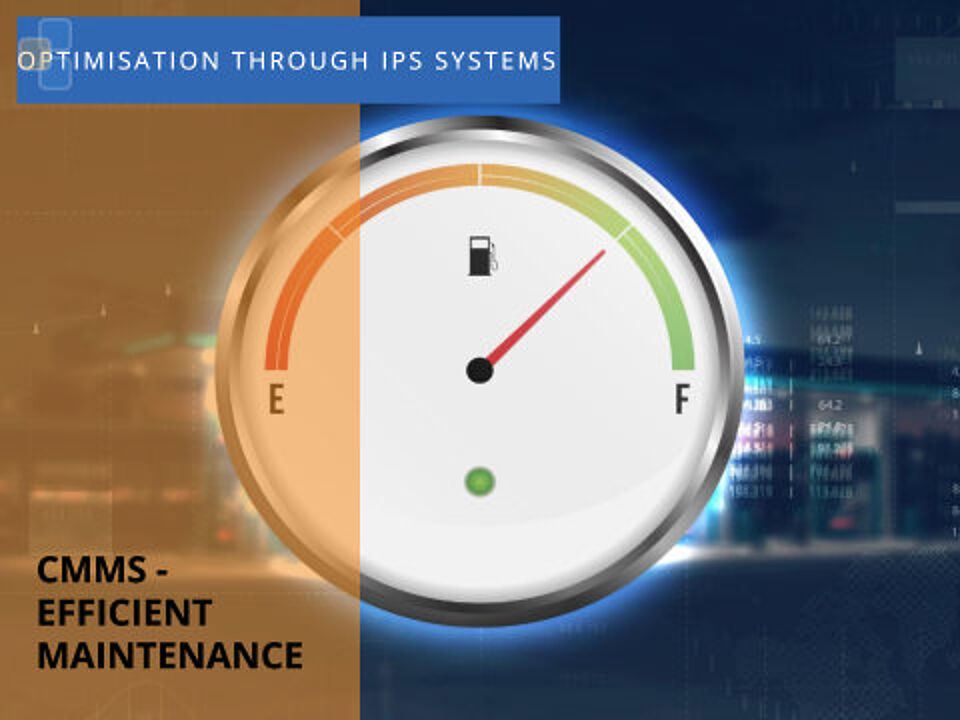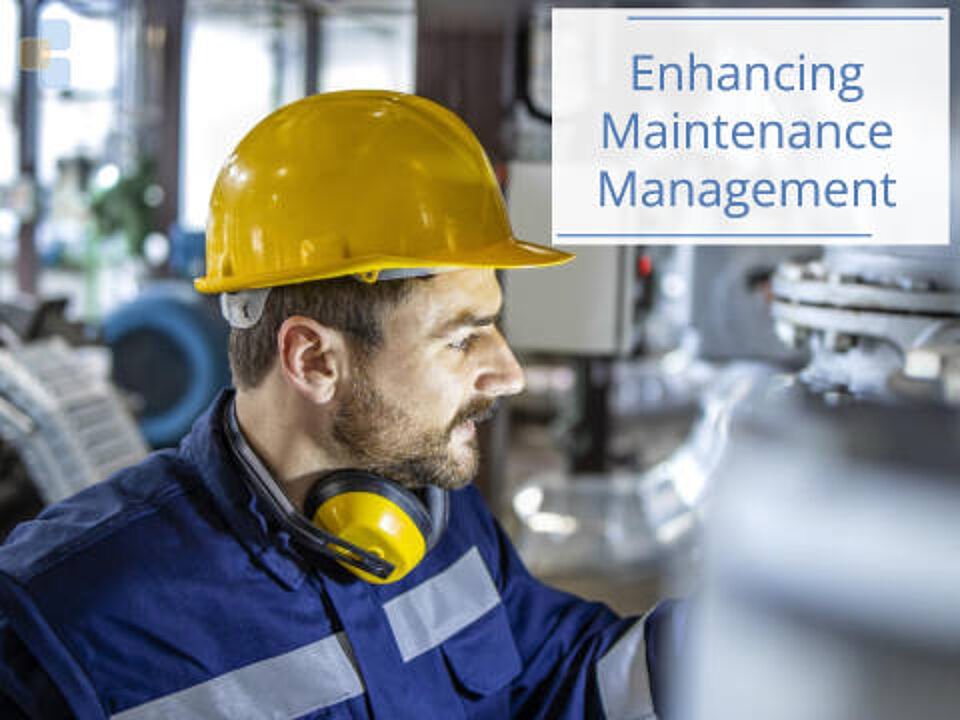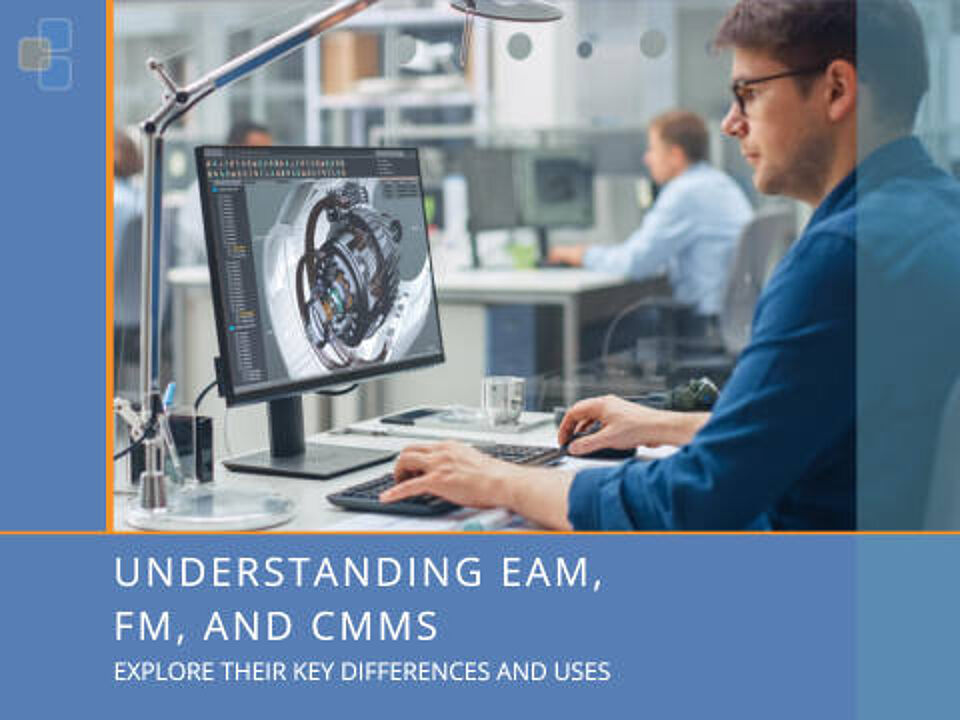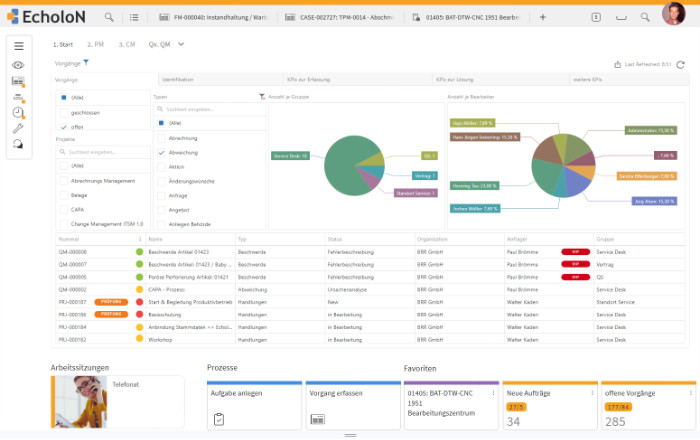
Author: Jochen Möller (CEO and CoFounder EcholoN)
Creation: 15.08.2022, last change: 04.05.2025
Table of contents
CMMS - Maintenance planning and control system (IPS)
How does a CMMS improve maintenance management processes?
Advantages of implementing a CMMS
CMMS vs. other maintenance management systems
First steps with a CMMS
Additional resources
How do EAM, FM and CMMS differ?
What you need to know about CMMS and Enterprise Asset Management
FAQ - Frequently asked questions
How can EcholoN help here?
CMMS - Computerised Maintenance Management System
Maintenance management is one of the most important aspects of asset management in any company. Maintaining the functionality and monitoring of machines and systems is essential for the smooth running of any business. The traditional way of maintenance management relied on paper-based documentation, spreadsheets and human memory, which was inefficient, error-prone and costly.
However, technological advances have revolutionised maintenance management. One of the most recent technological advancements in maintenance management is the introduction of the Computerised Maintenance Management system - or oder CMMS - maintenance Software.
In this blog post, we will discuss the CMMS and its importance in the field of maintenance management. We will also look at how a CMMS solution improves maintenance and asset management processes and the benefits it brings to companies that adopt it.
What is a computerised maintenance management system?
A Computerised Maintenance Management System is a software solution that, among other things, streamlines maintenance operations, tracks work orders and schedules preventive maintenance tasks. A CMMS enables a company to maintain and manage plant, equipment and machinery more efficiently.
A CMMS provides a central database of all maintenance-related information that can be easily accessed by technicians, facility managers and other staff responsible for maintenance. CMMS software helps companies to streamline maintenance processes, minimise downtime, extend the life of plant and machinery, and improve overall maintenance productivity.

How does a CMMS improve maintenance management processes?
How does a CMMS improve maintenance management processes?
A CMMS improves maintenance management processes in a number of ways, including:
Preventive maintenance
Preventive maintenance is one of the most important processes in maintenance management, and a CMMS plays a crucial role in this. The maintenance software schedules maintenance activities based on a predetermined time interval or usage limits. By scheduling maintenance activities in advance, companies can minimise the risk of equipment failure, reduce downtime and increase the reliability of plant and machinery.
Work order management
A CMMS helps manage maintenance work orders from start to finish. It allows technicians to receive work orders, report the progress of work orders and close work orders once the work is complete. CMMS software streamlines the work order management process, minimising paperwork and reducing the time it takes to complete maintenance tasks.
Asset and inventory management
A CMMS provides companies with a better way to manage asset and inventory. It allows companies to track the location, use and condition of plant, machinery and inventory in real time and ensure they are available when needed. By using a CMMS, companies can optimise their inventory, reduce downtime of plant and machinery and extend its life.
In summary, CMMS is an important tool for companies looking to optimise their maintenance and asset management processes. A CMMS enables companies to streamline their maintenance processes, minimise unproductive time and extend the life of plant and machinery.
Advantages of implementing a CMMS
The implementation of a CMMS can bring significant benefits to any company that relies on maintenance and assets. Here are some of the key benefits of a CMMS solution:
Increased productivity
With a CMMS, maintenance teams can work more efficiently by automating routine tasks, streamlining work order management and automating maintenance scheduling. With a CMMS, technicians spend less time on administrative tasks such as filling out work orders and searching for equipment, and more time on actual maintenance activities.
Cost savings
By automating maintenance processes, CMMS software can help companies save money on maintenance-related expenses, including spare parts stocking. CMMS software enables companies to optimise inventory and reduce equipment idle time, which can lead to significant cost savings in the long run.
Improved equipment reliability
Equipment and machinery reliability is critical for any business that relies on the effective operation of machinery and equipment. By scheduling preventive maintenance activities and tracking asset performance, a CMMS helps companies reduce unproductive time, extend the life of plant and machinery, and improve overall asset reliability.
Increased safety and compliance
A CMMS can help companies maintain safe and compliant operations. By scheduling regular maintenance activities and tracking asset performance, a CMMS can help companies identify potential hazards before they become safety issues. In addition, a CMMS can help companies comply with regulatory requirements by automating the recording and documentation of maintenance activities.
CMMS vs. other maintenance management systems
While there are many systems for maintenance management, CMMS software offer distinct advantages over other ways of working. Here are some of the key differences:
CMMS vs. paper-based way of working
Paper-based maintenance management systems are inefficient, error-prone and costly. Paper-based solutions require manual data entry, which is time-consuming and increases the likelihood of errors. In addition, paper-based work is difficult to manage, track and analyse, making it difficult to perfect maintenance processes.
CMMS vs. spreadsheets
While spreadsheets are an advance over paper-based systems, they still have significant limitations when it comes to maintenance management. Spreadsheets do not have the functionality of a dedicated CMMS solution, and they can be difficult to manage and update. In addition, spreadsheets are prone to errors and can be time-consuming to manage.
CMMS vs. Enterprise Resource Planning (ERP)
ERP solutions are designed to manage all aspects of a company's operations, including maintenance management. However, ERP solutions can be expensive and complex and may require significant customisation to meet the specific needs of a maintenance team. In addition, ERP software may not have the functionality of a dedicated CMMS solution, which can make it difficult to perfect maintenance processes.
In summary
In summary, a CMMS solution is an important tool for companies that depend on plant and machinery for efficient operations. By streamlining maintenance processes, optimising inventory and improving the reliability of plant and machinery, CMMS software offers significant benefits to any business. Whether you're in the manufacturing machinery and equipment industry, retail, healthcare or any other sector that relies on maintenance and assets, CMMS systems can help you reduce unproductive time, increase asset availability and uptime, save money and improve overall productivity.
First steps with a CMMS
If you are considering introducing a CMMS in your company, you can proceed in several steps:
Define your maintenance goals
Before selecting a CMMS solution, you need to define your maintenance goals. Think about what you want to achieve by using a CMMS tool, such as improving asset reliability, reducing non-productive time or optimising inventory levels. Once you are clear about your maintenance goals, you can select CMMS software that meets your requirements.
Evaluate CMMS solutions
Once you have defined your maintenance goals, you can start evaluating CMMS solutions. There are numerous solutions available, ranging from basic to advanced software systems. Consider the CMMS features you need in a CMMS system, such as work order management with checklists, preventive maintenance planning / preventive maintenance, asset and inventory management/asset management, and reporting with dashboards and analytics.
Choose the right CMMS provider
Choosing the right CMMS provider is critical to the success of your maintenance management system. Look for a provider with experience in the field, a proven track record and excellent customer support. EcholoN's holistic service management software is an excellent choice for companies of all sizes.
Train your staff
Once you have chosen a CMMS provider, you will need to train your staff to use the tool effectively. Proper training is critical to ensuring that your maintenance team can take full advantage of the features and capabilities of the CMMS solution. Be sure to provide ongoing training and support to ensure your team is always up to date on the latest features.
In summary
In summary, a computerised maintenance management system is an indispensable tool for companies that rely on plant and equipment for efficient operations. By streamlining maintenance processes, optimising inventories and improving the reliability of plant and machinery, a CMMS system offers significant benefits to any company. And with numerous CMMS solutions available, companies can choose software that meets their individual needs.
Additional resources
If you want to learn more about maintenance management systems and how they can benefit your business, here are some additional resources to check out:
This blog post provides an overview of maintenance management and describes the steps companies can take to improve their maintenance operations.
This blog post looks at the benefits of computer-aided facility management (CAFM) and how it can help organisations with maintenance management and asset tracking.
This page provides an overview of Field Service Management and how it can streamline your maintenance operations, increase efficiency and reduce costs.
This page provides an overview of Service Management and how it can help your business improve customer service, increase efficiency and streamline operations.
In summary, the introduction of a computerised maintenance management system can bring significant benefits to any business that relies on plant and machinery maintenance. By streamlining maintenance processes, optimising inventories and improving the reliability of plant and machinery, a computerised CMMS can help companies reduce unproductive time, save money and increase overall productivity.

How do EAM, FM and CMMS differ?
To understand the difference between EAM, FM and CMMS, it is important to know the differences.
EAM stands for Enterprise Asset Management, which focuses on the management of an organisation's plant and machinery throughout its lifecycle. This also includes the planning, procurement, commissioning, operation, maintenance and decommissioning of this plant and machinery.
FM stands for facility management, which is the management of an organisation's facilities to ensure smooth operations. This includes the management of physical assets such as buildings, premises and equipment.
CMMS stands for Computerised Maintenance Management System. This system is designed to manage and streamline maintenance operations for various types of assets, including equipment, machinery and vehicles. It helps companies plan, manage and track maintenance activities, preventive maintenance schedules and asset repair histories.
The main difference between EAM, FM and CMMS is the focus of each system. EAM focuses on asset management, while FM focuses on facility management. CMMS, on the other hand, focuses on managing maintenance activities for plant and machinery.
In practice, these systems work together to manage a company's assets and facilities. EAM and FM can help manage and plan maintenance schedules and assess asset reliability and lifecycle costs. CMMS, in turn, can help execute these maintenance plans and track the maintenance history of assets.
By integrating these solutions, companies can achieve a holistic approach to managing their asset and facilities. They can improve the effectiveness of maintenance operations, reduce unproductive time and control maintenance costs.
To learn more about maintenance management, read our related articles on maintenance inspections, repair, computerised facility management, field service management, customer service, service management and service portals.
What you need to know about CMMS and Enterprise Asset Management
When it comes to maintenance management, both Computerised Maintenance Management Systems and Enterprise Asset Management (EAM) software can play a crucial role. Understanding the differences between these two systems is critical for companies looking to improve their overall maintenance operations.
While both systems focus on managing maintenance activities, they approach the challenge in different ways. A CMMS system is primarily designed to manage the maintenance of specific pieces of plant or machinery. It helps companies streamline maintenance procedures, track work orders, schedule preventive maintenance activities, document repairs and ensure compliance.
The EAM system, on the other hand, is designed to manage the entire lifecycle of systems, from procurement to decommissioning. It helps companies track assets, plan maintenance activities, manage investments and assess asset reliability.
One of the main differences between CMMS and EAM solutions is the level of detail. CMMS is focused on discrete maintenance events such as work orders, while EAM solutions are focused on the assets and machines themselves and their information. However, both systems ultimately aim to improve the reliability of plant and machinery, reduce maintenance costs and increase safety.
By integrating a CMMS with EAM, companies gain even greater control over maintenance operations. By combining these two systems, companies can optimise preventive maintenance plans based on asset reliability, track maintenance costs and ensure compliance. This integration also provides a consolidated view of the entire asset management lifecycle.
Ultimately, the decision between CMMS and EAM solutions depends on the specific needs of each company. However, companies should look for a system with comprehensive functionality that includes asset tracking, maintenance scheduling, audits, work order management and reporting, as these functions help track the overall health of asset and machinery throughout their lifecycle.
In summary, when it comes to maintenance management, it is important to choose the right system for the job. Both CMMS and EAM solutions play an important role in modern maintenance practice. By integrating these two systems, companies can optimise their maintenance processes and achieve their goals more efficiently.
Frequently asked questions
What is a CMMS?
- CMMS stands for Computerised Maintenance Management System. It is a software system that helps companies manage their maintenance operations, plan maintenance activities, track the maintenance history of equipment, plant and machinery, and perfect maintenance procedures.
What are the benefits of using a CMMS?
- There are many benefits to implementing a CMMS, such as improved maintenance efficiency, reduced downtime and increased reliability of plant and machinery. CMMS can also help reduce maintenance costs, track compliance and asset history, and enable predictive maintenance to identify and correct problems before they lead to downtime or other issues.
What types of maintenance activities can be managed with a CMMS?
- CMMS can help manage all types of maintenance activities, including reactive, preventive and predictive maintenance tasks. It can also track inventory, manage work orders, schedule tasks and resources, and automate maintenance operations.
How does CMMS integrate with other business systems?
- CMMS can be integrated with other business systems, such as enterprise resource planning (ERP), supply chain management (SCM) and asset management software, giving companies comprehensive information about their assets and operations.
What does a typical CMMS implementation look like?
- A typical CMMS implementation involves understanding the company's maintenance operations, identifying key performance indicators (KPIs), training team members to use the software and configuring the solution to automate the company's maintenance processes.
How can I choose the right CMMS system for my company?
- Choosing the right CMMS tool for your organisation depends on the size and complexity of your maintenance operations, your budget and your goals. The most important factors to consider when selecting a CMMS solution include functionality, ease of use, scalability and integration capabilities.
Is CMMS suitable for all types of industries and organisations?
- Yes, CMMS can be used by any organisation that has maintenance needs, regardless of the industry.
How can EcholoN help here?
EcholoN helps corporate maintenance managers perfect their maintenance management processes with a range of holistic service management software solutions. Our software is designed to help companies reduce downtime, extend the life of plant and machinery, and improve overall operational efficiency.
With EcholoN's field service management solutions, companies can streamline their maintenance operations, track the performance of their plant and machinery, and optimise their inventory. With our customer service solutions, companies can provide world-class customer service, automate service requests and track service performance metrics. And with our software service portals, companies can offer self-service options to their customers, which can help reduce service costs and improve customer satisfaction.
In addition to these solutions, EcholoN's software offers numerous features and functions that can help companies perfect their maintenance management processes, including
- Preventive maintenance planning
- Work order management
- Inventory and asset management / Enterprise Asset Management
- Reporting and analysis
- Real-time collaboration and communication tools
- Mobile access and offline functions
- web-based CMMS, also available offline, anytime and anywhere
- mobile devices
EcholoN's holistic service management software is designed to meet the unique needs of organisations across a wide range of industries and company sizes. With our software, companies can improve their maintenance processes, reduce costs and achieve their maintenance management goals.
In summary, EcholoN's suite of holistic service management software solutions can help organisations perfect their maintenance management processes. EcholoN has the expertise and experience to help your business become more efficient and productive.
If you want to optimise your maintenance management processes (ongoing maintenance, preventive maintenance or predictive maintenance), take a look at EcholoN's holistic service management software and learn how our field service management, customer service, service management and software service portal solutions can help your business.
Maybe also interesting:
Blog article: Maintenance and repair - relevant key performance indicators (KPIs) through CMMS software
Blog - Article: Computer Aided Facility Management - CAFM

